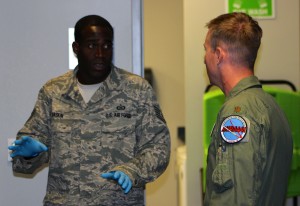By Robbin Laird
During my visit to the 33rd Fighter Wing, I had a chance to talk with a couple of the folks involved in shaping the evolution of the life support system.
Sargent Baskin and Sargent Velasquez discussed with me the challenge of evolving from the legacy to the F-35 support system.

As they explained it, the legacy helmet and associated systems evolved over time and had new devices attached, such as Night Vision Goggles and Joint Helmet Mounted Cueing System (JHMCS).
With the new helmet, the approach is to integrate the systems.
The challenge, of course, is to get the integration right.
This means as well that the new challenge will be to maintain the integrated helmet, rather than piece repairs.
This poses its own challenge as the pilots are fitted with an interrelated helmet which is uniquely his or hers. How do you fly if your helmet is not working?
One alternative over time might be to have a backup helmet, but more plausibly, the ability to repair an integrated helmet will evolve over time with the input from top Aircrew Flight Equipment technicians like TSgt Baskin and SSgt Velasquez.
TSgt. Baskin: “Instead of attaching mission specific devices to the helmet, the F-35 helmet has the key elements fully incorporated; one example would be night vision capability. The helmet essentially pulls up the sensor data from the jet and allows the pilot to focus more effectively on his tasks and avoid cockpit distractions.
When you fly with a legacy helmet, you have to wear earplugs. With the new helmet you don’t. It has active noise reduction incorporated in the helmet. It basically reduces all the noise all around them, so they can focus on what’s coming through inside this aircraft.
And each pilot has their own helmet.
The sizing process is actually laser scanned, so once it’s fit to them, it’s their helmet and their helmet only.
There’s no swapping helmets among pilots.
SSgt: Velasquez: “We are here to help work the solutions towards a more effective integrated helmet over time. You don’t start at 100%: you work towards that goal. And one task is to shape an effective troubleshooting process for the new helmet so that we can have a more effective repair process over time.
Also present in the room were pilots from Luke AFB who at Eglin providing the chase planes for the F-35A. There presence also underscored another key part of standing up new squadrons, namely the cross learning across the bases as the F-35 fleet is stood up.
And see our regular update on the F-35, which can be found here
https://www.sldinfo.com/f-35-consortium/


